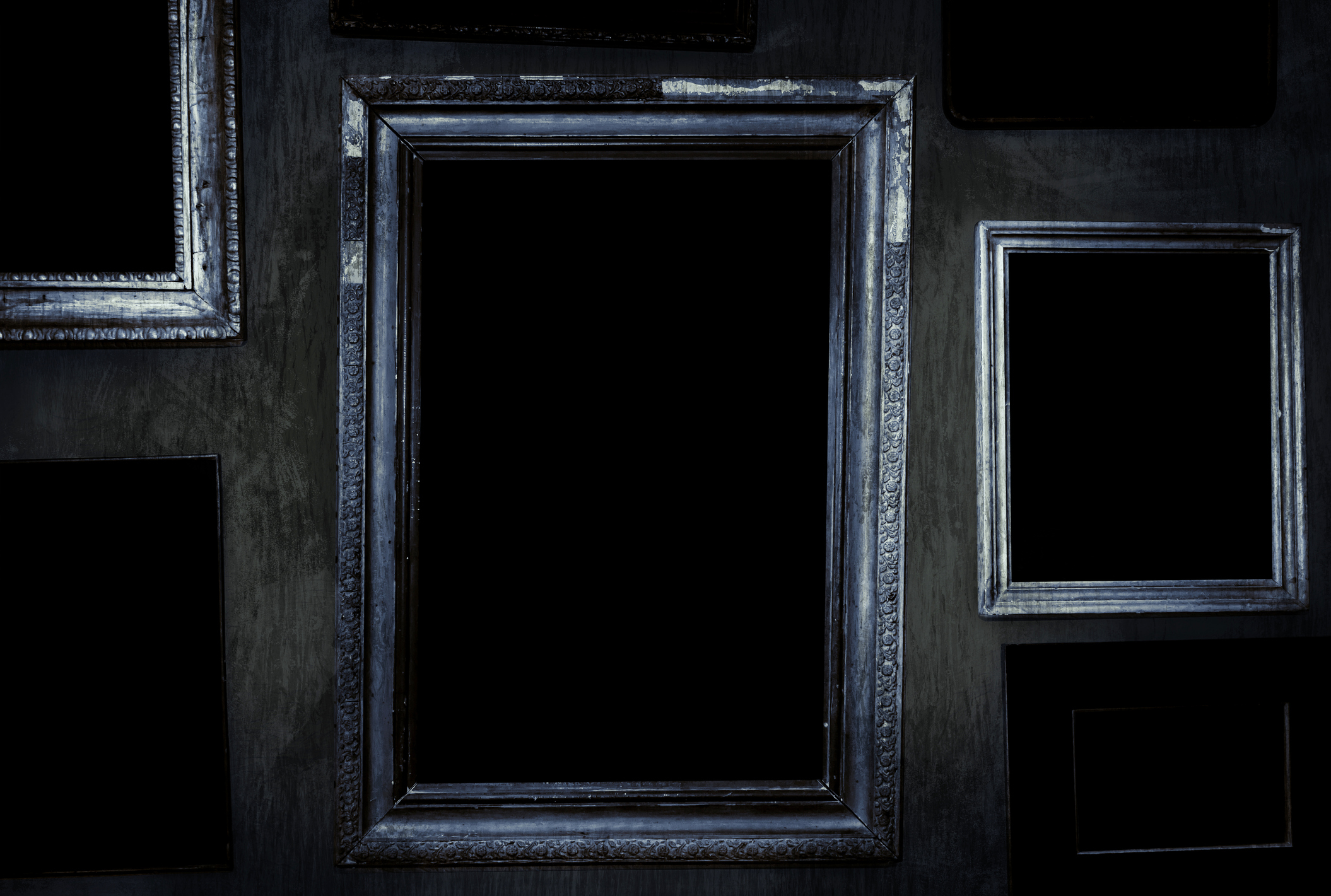
The Most Haunting Paintings In Art History
To get into the Halloween season, we made a list of some of art history’s most terrifying and spine-tingling artworks. From Renaissance old masters to Modern market heroes, here are 10 of the scariest paintings in Art History.
The Four Horsemen of the Apocalypse (1502) – Albrecht Dürer
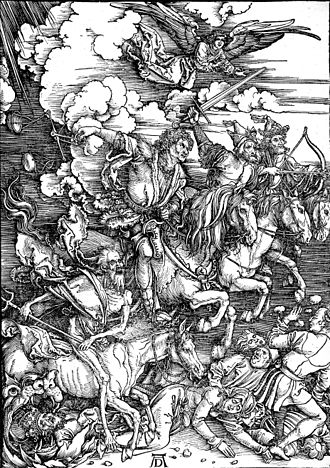
Albrecht Dürer was a prominent Northern Renaissance artist during the early Renaissance period. The Four Horsemen of the Apocalypse was part of his woodcut prints illustrating the Biblical prophecies regarding the coming of the Apocalypse.
The print showcases the prophecy of the apocalypse, with each rider representing a different stage. The first was the Conqueror, followed by War, Famine, and then Death, respectively.
The Four Riders are entering the scene with great haste as if driven by a propelling force that will stop them for no one. Their horses are trampling on various figures lying below them on the ground, ensuring chaotic carnage.
We see one figure still standing, his left hand up in a reflex to shield himself while trying to get away. But this seems an impossible task, and he will soon be among those bodies lying on the ground, soon to be consumed by death — represented by a beat in the lower left corner.
Garden of Earthly Delights (1503-1515) – Hieronymus Bosch
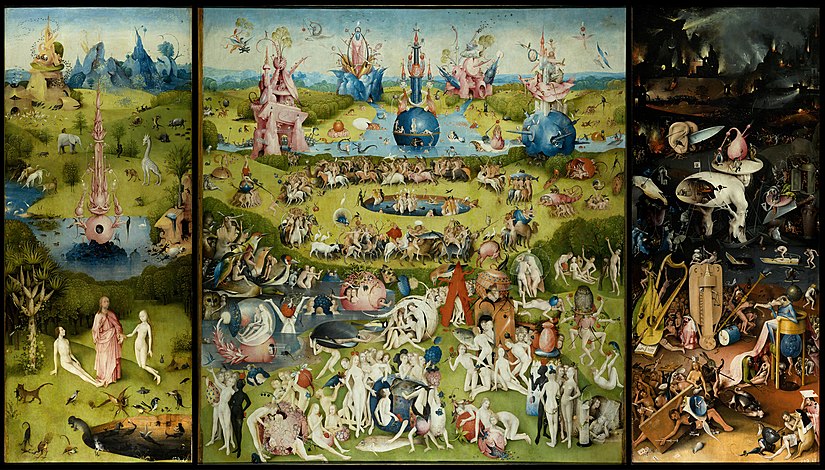
Though he lived 500 years ago, Hieronymus Bosch remains the master of the macabre. The Early Netherlandish Renaissance artist is known for his surreal paintings of otherworldly settings — like the fantastic and frightening Garden of Earthly Delights.
While little is known about the origins of this triptych, it remains Bosch’s most resonant work of art. Featuring hybrid animals, make-believe machines and everything in between, the chaotic painting strikes a perfect balance between eye-catching peculiarity and nightmare-inducing horrors — especially when observed in detail.
A whimsical interpretation of the Bible’s Story of Creation, the Garden of Earthly Delights proves that any subject can be scary if given a surreal twist.
Medusa (1618) – Peter Paul Rubens
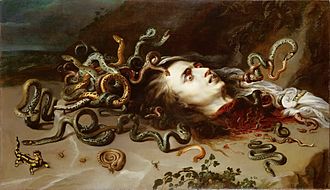
Ever since antiquity, depictions of the head of Medusa with protruding tongue, exposed teeth, and snake-shaped hair were seen on soldiers’ shields and at the entrance to buildings as a talisman warding off danger.
Caravaggio captured the famous monster in Greek mythology. Eight years later, Rubens immortalized Medusa in his own interpretation. Significantly, we see the moment when Perseus struck her, her head fell to the ground, and the vermin jumped in all directions.
Rubens’ Head of Medusa differs from Caravaggio’s work in composition and the selected motif. Whereas Caravaggio showed the Gorgon at the moment of her final cry before death, Rubens captured the head of a woman already dead on canvas.
Her deathly pale face with frozen gaze, glassy eyes, and half-open mouth is filled with an expression of horror. Although Medusa is dead, her repulsive snakelike hair continues to live. The snakes appear to twist, shake and intertwine, forming moving rings and balls. The drops of blood which have fallen to the ground give rise to small, newborn snakes.
The Nightmare (1781) – Henry Fuseli
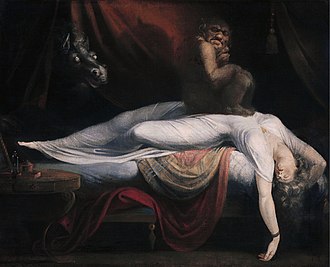
Henry Fuseli was a leading figure of Romanticism, a 19th-century art movement defined by dreamy iconography. In his most famous painting, The Nightmare, Fuseli delves into the scary side of the subconscious.
This spine-tingling work of art shows a sleeping woman with an incubus, a male demon that preys upon women as they sleep, perched on her body. A ghostly horse emerges from behind a red velvet curtain, forming the only perceivable part of the blackened background.
Most art historians believe that German folktales inspired the painting. According to legend, men who slept alone were visited by horse specters, while demons or the devil possessed lone women. By incorporating both frightening figures in the composition, Fuseli visually represents the manifestation of a living nightmare.
Saturn Devouring His Son (1819-1823) – Goya
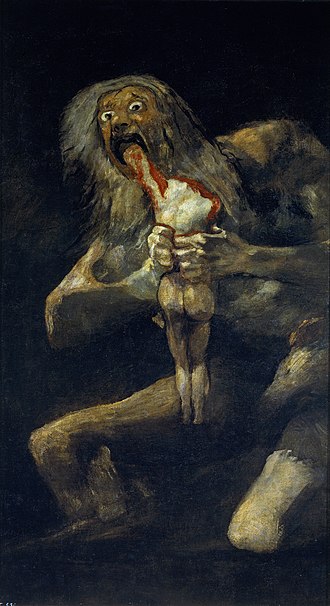
Between 1819 and 1823, the Spanish artist Francisco Goya created his Black Paintings, a series of 14 particularly haunting pieces. The most famous of these works is Saturn Devouring His Son, a gruesome painting of a father feasting on his own child.
According to Roman mythology, was the leader of the Titans. Saturn overthrew his father, Caelus, to become ruler of the universe. Fearing his own offspring would do the same, he killed and consumed each child shortly after birth — an atrocity Goya opted to portray in this Black Painting.
Takiyasha the Witch and the Skeleton Specter (1844) – Utagawa Kuniyoshi
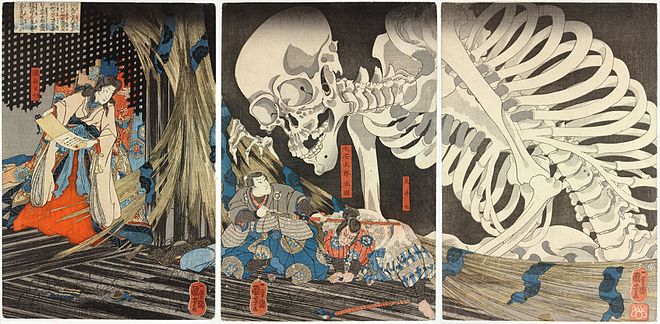
Edo period artist Utagawa Kuniyoshi created the woodblock print Takiyasha the Witch and the Skeleton Specter, in which a giant skeleton looms over two samurais as a woman reads a scroll in the wings. The unsettling image is based on a story from the Heian period in Japan that took place in 939 CE.
At that time, samurai warlord Taira no Masakado traveled from his home in Kantō and led an army to rally against the central government in Kyoto. He eventually tried to set up his own court in Shimōsa Province, but was defeated and decapitated. His daughter, Princess Takiyasha, continued to live in the family’s home, turning to witchcraft and studying dark magic.
Kuniyoshi’s piece shows her reading a spell to bring forth a Gashadokuro, a spirit that takes the form of a giant skeleton. It looks over Ōya Taro Mitsukuni and another samurai who were both sent to get the princess. The haunting spirit foiled their plans.
Skull of a Skeleton With a Burning Cigarette (1885-1886) – Vincent Van Gogh
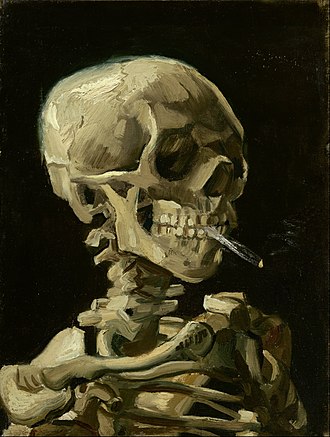
Horror might not be the right word when describing this painting by Vincent van Gogh, but it certainly is creepy. One of the artist’s earliest works of art, the oil painting depicts a skeleton smoking a cigarette set against a stark, dark background.
Many believe it was a dig at the conservative practices of the Royal Academy of Fine Arts, where Van Gogh was studying at the time and often felt slighted regarding his creative process.
The painting is very eye-catching and haunting when discussing a lifeless corpse smoking a cigarette.
Girl WIth Death Mask (1938) – Frida Kahlo
Mexican painter Frida Kahlo is known for her collection of 55 self-portraits. While her most well-known works feature the artist as an adult, she also portrayed herself as a child in Girl with Death Mask (She Plays Alone).
This peculiar piece depicts a young girl standing before a barren landscape. In her hand, she holds a single yellow flower and, on her face, she wears a skull mask. Both of these props are characteristic of Día de los Muertos — or Day of the Dead — prompting the viewer to reflect upon death-related themes. Finally, a beastly mask rests at her feet, adding even more mystery to the chilling painting.
Girl with Death Mask (She Plays Alone) was painted in 1938 — the year before her dramatic divorce from fellow artist Diego Rivera. Like many works created during this time, this piece was likely inspired by Kahlo’s feelings of isolation and loneliness.
Study After Velazquez Portrait of Innocent X (1953) – Francis Bacon
One of the most famous artists of the 20th century was the Irish-born Francis Bacon. For inspiration, Bacon repeatedly referred to the works of other artists, including the Spanish baroque painter Diego Velázquez.
In 1953 he used Velázquez’s portrait of Pope Innocent X as a template for one of his own works. He transformed it to look like the head of the Catholic Church was screaming. Some now say that with this work, Bacon dealt with his father’s death, who had died shortly before. Others think that he only wanted to express his atheism.
Little Electric Chair (1964) – Andy Warhol
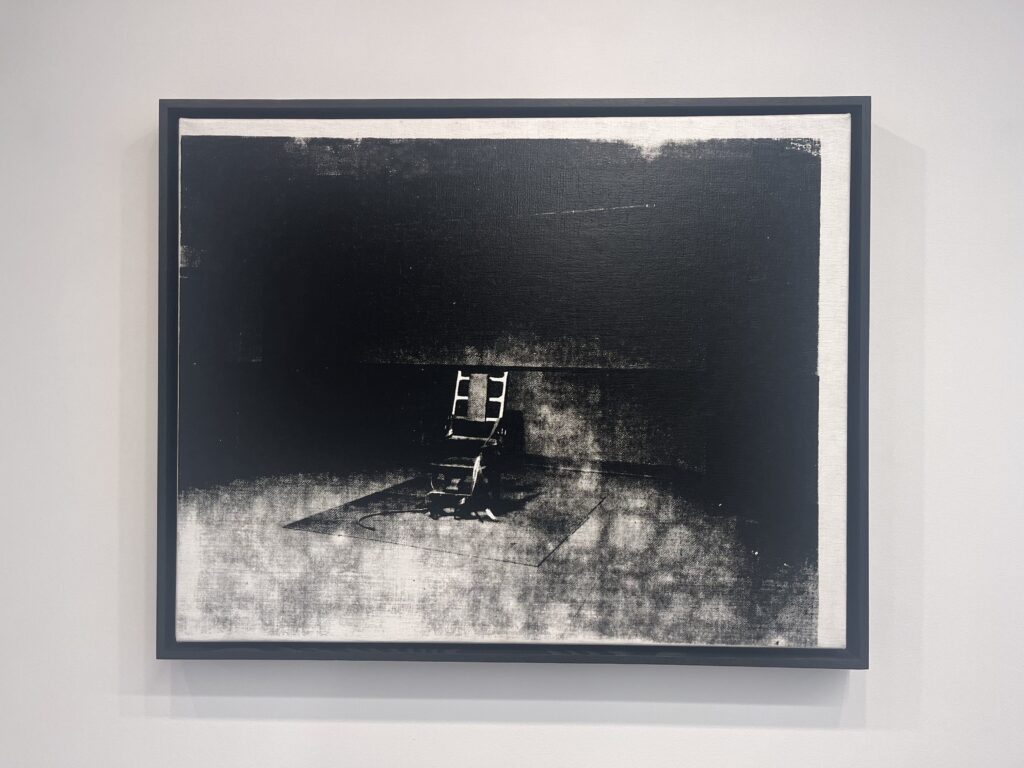
In the early 1960s, Pop Art founder Andy Warhol pioneered silkscreen painting. Crafted using a combination of acrylic paint and the silkscreen method — a mechanical printmaking process in which the artist transferred paintings on canvas onto paper — these works allowed the artist to translate photographs into multiple “factory-produced” works.
While Warhol’s most famous silkscreen paintings feature popular celebrities and everyday objects as their subjects, his series took a darker turn in 1962 when he started his Death and Disasters series. This series featured everything from devastating car accidents to poisonous cans of tuna to a Big Electric Chair, a painting inspired by a press photograph from the prison where Julius and Ethel Rosenberg were executed.